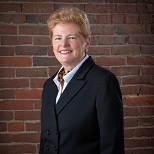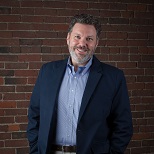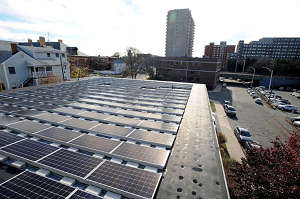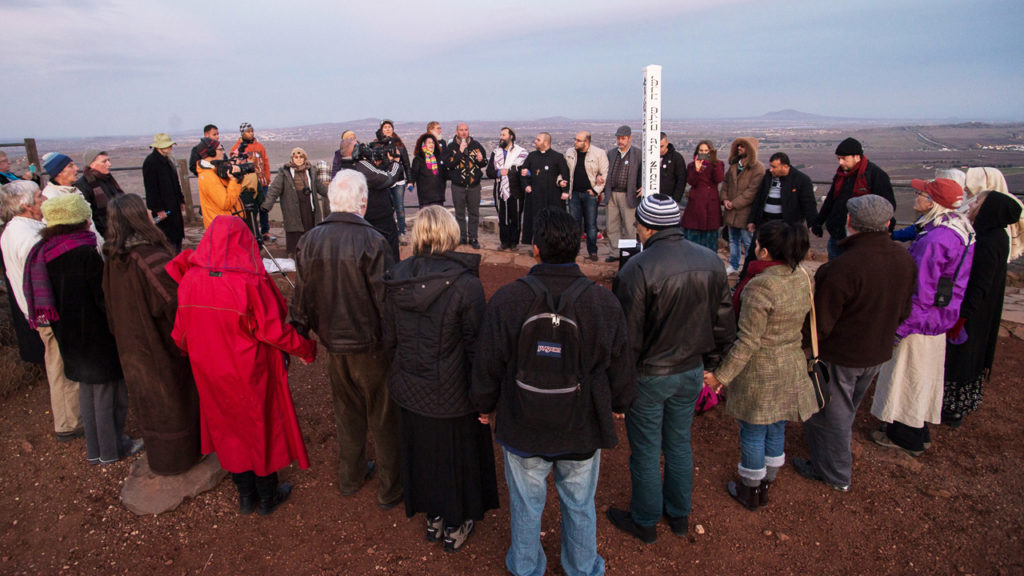
Cynthia A. Arcate, President and CEO

Liam Sullivan, VP of Marketing and Communications
By Krystin Gollihue
In 1996, Massachusetts began the process of deregulating its energy market, opening up electricity and natural gas supply to competition. This meant that for the first time businesses would be able to shop around for their energy supply, compare offers and find the most advantageous arrangements. Robert J. Ciolek, then executive director of the Massachusetts Health and Educational Facilities Authority (HEFA), didn’t know anything about energy, but he recognized that nonprofit organizations could benefit from these open, competitive markets.
 HEFA, an agency that until then had been solely focused on providing tax-exempt financing to large nonprofit health and educational institutions, formed PowerOptions, consolidating the buying power of nonprofits of every sector and size. Timing was perfect, and PowerOptions was first to market with a competitive energy supply offering. To earn PowerOptions’ strong market share, suppliers bid very competitively, which especially in the early years led to substantial savings for participating nonprofits. In 2010, HEFA was merged into another state agency, and PowerOptions became a stand-alone nonprofit, formalizing its mission to help nonprofits save time and money on energy.
HEFA, an agency that until then had been solely focused on providing tax-exempt financing to large nonprofit health and educational institutions, formed PowerOptions, consolidating the buying power of nonprofits of every sector and size. Timing was perfect, and PowerOptions was first to market with a competitive energy supply offering. To earn PowerOptions’ strong market share, suppliers bid very competitively, which especially in the early years led to substantial savings for participating nonprofits. In 2010, HEFA was merged into another state agency, and PowerOptions became a stand-alone nonprofit, formalizing its mission to help nonprofits save time and money on energy.
After the first several years, PowerOptions determined that a more structured membership model would better suit the needs of both their nonprofit customers and the organization itself. Cynthia Arcate, President & CEO, says, “We wanted to make people feel like they were a part of something bigger—part of a community of nonprofits working together for the benefit of all involved.” In 2002, PowerOptions created a dues schedule based on organization size, with the only requirement for membership being that an entity had to be a nonprofit, municipality, or state or federal agency.
 While group purchasing is a relatively common model in industry sectors, it has proven particularly successful for PowerOptions which has grown to be the largest energy buying consortium in New England. What helps make PowerOptions so effective is its diverse customer base, with members representing every nonprofit sector. “For energy, it’s not just how much you buy, it’s when you use it,” Arcate notes. There are peak times of usage, when electricity demand is high. “But when you have a diverse customer base like we do,” Arcate says, “it creates a very desirable usage profile. Our customers fill in the peaks and valleys of use.” Schools use energy during the day, housing authorities tend to use energy in the evening, and hospitals run 24-seven. This makes PowerOptions unique and gives them leverage in the market and at the negotiating table. But PowerOptions has become much more than just a source of energy supply for its members.
While group purchasing is a relatively common model in industry sectors, it has proven particularly successful for PowerOptions which has grown to be the largest energy buying consortium in New England. What helps make PowerOptions so effective is its diverse customer base, with members representing every nonprofit sector. “For energy, it’s not just how much you buy, it’s when you use it,” Arcate notes. There are peak times of usage, when electricity demand is high. “But when you have a diverse customer base like we do,” Arcate says, “it creates a very desirable usage profile. Our customers fill in the peaks and valleys of use.” Schools use energy during the day, housing authorities tend to use energy in the evening, and hospitals run 24-seven. This makes PowerOptions unique and gives them leverage in the market and at the negotiating table. But PowerOptions has become much more than just a source of energy supply for its members.
“Over the last 10 years,” Arcate says, “we’ve been increasing the service and value we bring to members, making people think and feel about PowerOptions as an organization, not just a commodity contract.” Since implementing their membership structure, PowerOptions has broadened offerings to include electric vehicle charging stations, assistance with energy efficiency and energy budget preparation. They also provide members with monthly energy market updates, industry and regulatory news, and advocate on behalf of members for issues related to cost and reliability. PowerOptions now advises members on when to buy energy and the most beneficial pricing structure for their specific needs. “We want to address all of our members’ energy needs,” added Arcate, “which can vary greatly depending on the member.”
Liam Sullivan, Vice President of Marketing & Communications, adds, “Some of our members have large campuses with sophisticated needs. We might be working with one member’s experienced energy team, and we might also be serving a single executive director making decisions for his facility. We provide services to both.”
PowerOptions had a very successful entry into the solar energy market as well, with participating members expected to save more than $120 million over 20 years. Many of their members, like universities and public entities, experience pressure from constituents to move toward greener energy. PowerOptions responded to members’ needs, and they leveraged the power of the consortium to create an innovative solar program based on the tenants of all of their programs: competitive price, consumer protections, and PowerOptions’ guidance. “We extract from the market the value that we’re providing on behalf of our members, and we’re giving it back to them,” Arcate says. And PowerOptions provides value to the market—members purchase approximately $200 million of electricity and natural gas annually through their programs.
This approach is a significant turn in the power dynamic between the business and nonprofit sectors. PowerOptions operates in a very competitive industry. To succeed, as they have, they must offer a full suite of products and services, provide customer care, build customer relationships and market themselves. Their members do not buy from them because they are a nonprofit; they buy from them because PowerOptions offers the best energy supply arrangements available in the market today. It’s a reciprocal arrangement—the greater the number of members, the larger PowerOptions’ leverage in the market, which in turn allows for even better competitive offerings.
Following this model has led to success for PowerOptions. As part of giving back to its members, PowerOptions celebrated their 20th anniversary with a 20 for 20 giveaway – $10,000 to 20 different members. Funds put directly into the bottom line of their members, to further their missions. They’ve added programs where they’ve seen a need, and done so in the context of an extremely competitive market. Arcate says that you have to know how to play in the market, how to recognize the value that you can secure for your constituents and the value they add to the market.
Whether it’s helping the Manet Community Health Center pay for emergency generators, providing access to the wholesale energy market for Beth Israel Deaconess Medical Center, helping the Malden YMCA benefit from solar power, or assisting the Franklin Park Zoo with a boiler changed-out, PowerOptions continues to evolve in pursuit of its basic mission: helping nonprofits to save time and money on energy, so more resources can be directed toward their own important missions.
A respected energy expert with 30 years of experience in government and the private sector, Cynthia A. Arcate has an extensive background in utility regulation and operations as well as energy policy and markets. Arcate began her leadership at PowerOptions in 2009, as President and CEO of the premiere energy-buying consortium of non-profits and government entities in Massachusetts, with recent expansion into Connecticut and Rhode Island. She articulates the strategic vision of PowerOptions, managing a highly-skilled staff who implements its annual $160- 200 million electricity, natural gas and solar programs. Arcate also acts as a hands-on advocate for its more than 400 members in many state and regional forums. She currently serves as a member of the Energy Efficiency Advisory Council representing the non-profit sector and has served as a Vice Chair of the New England Power Pool, representing the End Use sector. Arcate’s extensive government and regulatory experience began as a staff attorney at the Federal Energy and Regulatory Commission (FERC). She then spent 15 years as a regulatory attorney and senior executive at New England Electric System, now National Grid. She returned to government as Deputy Commissioner for Programs at the Massachusetts Division of Energy Resources (DOER), where she had the overall responsibility for many programs of the agency. Before taking the helm at PowerOptions, Arcate was director of business development in New York and New England for Comverge, Inc., a clean energy provider that specializes in demand response and energy efficiency. Prior to her role at DOER, Arcate was Executive Director of the Boston Area Rape Crisis Center. Arcate is a 2016 recipient of the New England Women in Energy and Environment Achievement Award. She serves on the Board of the Northeast Clean Energy Council. Arcate earned her law degree from New York Law School and a Bachelor of Arts from St. Lawrence University.
A communications professional with more than 25 years of experience in the public and nonprofit sectors, Liam Sullivan has a broad background in stakeholder relations, program development, market research, branding and messaging. As Vice President of Marketing and Communication for PowerOptions, Liam creates the overall communications strategy, overseeing all traditional and digital marketing, media relations, market research, social media and events. He has guided the rebranding of PowerOptions and the growth of the marketing department, and is a member of the senior leadership team. Earlier in his career, he was one of the founding employees of PowerOptions, managing the effort to grow the consortium and launch its first energy program. Prior to his current role at PowerOptions, Liam was the Director of Public Affairs for the Massachusetts Health and Educational Facilities Authority, one of the largest municipal bond issuers in Massachusetts. He led the marketing, communication and lobbying teams. There he created a grant program for community health centers, launched a New Markets Tax Credits program and designed a successful educational series. Liam has also held positions at the Massachusetts Department of Mental Health, the Massachusetts Society for the Prevention of Cruelty to Children, and the Pioneer Valley Transportation Authority. Liam earned his Bachelor’s Degree in Economics from the University of Massachusetts at Amherst and holds a Master’s Degree from Emerson College in Integrated Marketing Communications. He is a member of the WGBH Corporate Executive Council and supports nonprofit organizations working to address homelessness, poverty and injustice.
Krystin Gollihue is an Assistant Editor and the Multimedia Production Strategist for Philanthropy Journal. She received her PhD in Communication, Rhetoric & Digital Media at NC State University. Her research looks at technology, farms, and resilience in the rural South.





